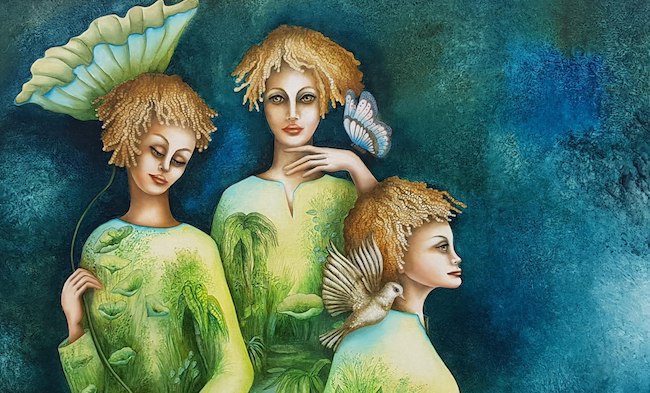Alcuni artisti contemporanei, piuttosto che legarsi alla realtà oggettiva, per esplorarla o per accoglierla come parte fondante del proprio linguaggio espressivo, scelgono al contrario di allontanarsi da essa, per dar vita a un mondo in cui tutto è più elevato, meno contingente, meno legato a quegli alti e bassi, a quelle difficoltà affiancate da istanti piacevoli che contraddistinguono il vivere attuale; la scelta di generare una dimensione differente spesso è esigenza di una spiccata sensibilità che necessita di astrarsi dalla quotidianità per entrare in un universo più poetico, musicale nella sua dolcezza, quasi magico. Sono esattamente questi i tratti distintivi dell’artista di cui vi parlerò oggi.
Il bisogno di evadere da una realtà troppo faticosa, o triste, o limitata, ha contraddistinto diversi artisti che nel corso dei secoli si sono avvicendati e che hanno posto l’accento su un mondo parallelo fatto di simboli, di significati nascosti, di rivelazione delle energie sottili che corrono e avvolgono l’uomo quando si mette in connessione con la natura, con le sue impetuosità o semplicemente con una spiritualità spesso lasciata in silenzio; dunque prima di tradursi in veri e propri movimenti pittorici questo percorso fu affrontato in solitaria da alcuni precursori o interpreti singolari di una corrente più ampia. Tra i primi ad affrontare tematiche che andavano oltre la razionalità, che scavavano all’interno dei meandri della fantasia e dell’impossibile fu Hieronymus Bosch in quale in maniera metaforica, attraverso il suo imprevedibile mondo visionario, sottolineò i conflitti dell’uomo nei confronti delle regole dettate dalla religione a cui sembrava impossibile non ribellarsi; poco dopo fu invece il Simbolismo a esplorare il mondo dell’inconoscibile, delle sensazioni intuibili ma non dimostrabili che si nascondevano oltre l’osservato, oltre la realtà tangibile ma che venivano svelate in virtù della sensibilità percettiva dell’artista. Con l’avvicinarsi del Novecento il mondo dell’emozione, del sogno, dell’evasione dalla realtà oggettiva fu consacrato da alcuni grandi maestri considerati outsider degli stessi movimenti a cui aderivano, come il sognatore ed eterno fanciullo espressionista Marc Chagall, tutto l’intero Surrealismo dove però la dimensione evidenziata era piuttosto quella dell’incubo, delle ansie e degli interrogativi inconsci sulla vita che si manifestavano nella fase del sonno quando cioè la parte razionale era messa a tacere, e infine il Realismo Magico che si poneva in ascolto dell’incanto inconsapevole che ruotava intorno all’essere umano il quale appariva cullato e al tempo stesso estraniato da quella sensazione. Dunque le opere del maestro Chagall, vere e proprie fiabe in cui i protagonisti e la realtà sembravano appartenere al mondo di zucchero di Hansel e Gretel, le atmosfere evanescenti ed enigmatiche del Surrealismo di René Magritte e il fascino semplice quanto onirico del mondo a metà tra realtà e immaginazione del grande rappresentante del Realismo Magico Antonio Donghi, tutte contribuirono a indirizzare i fruitori dell’arte verso un livello lontano dalla realtà pur mantenendone le caratteristiche di figurazione ma riadattandole al punto di vista e approccio all’espressione creativa di questi grandi maestri del Ventesimo secolo. L’artista di origini italiane ma naturalizzata svizzera Monica Cattaneo sembra compiere nella sua pittura una perfetta fusione dei tre stili pittorici sopra citati, l’Espressionismo di Marc Chagall, il Surrealismo di René Magritte e il Realismo Magico di Antonio Donghi, dando vita a un personale e originale linguaggio in cui la natura e il rapporto dell’essere umano con essa diviene punto focale.
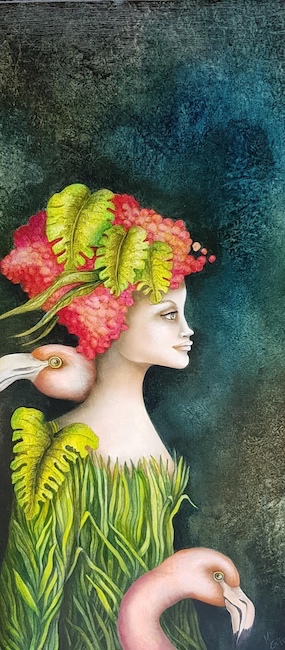
Le sue protagoniste, prevalentemente donne, sembrano uscire da un mondo parallelo in cui l’atmosfera è rarefatta, sospesa tra realtà e sogno, tra immagini riconducibili a dettagli che lo sguardo riconosce e dimensione quasi paradisiaca in cui tutto ciò che circonda l’essere umano è l’elemento della flora e della fauna, che si trasforma in coprotagonista della tela stessa.
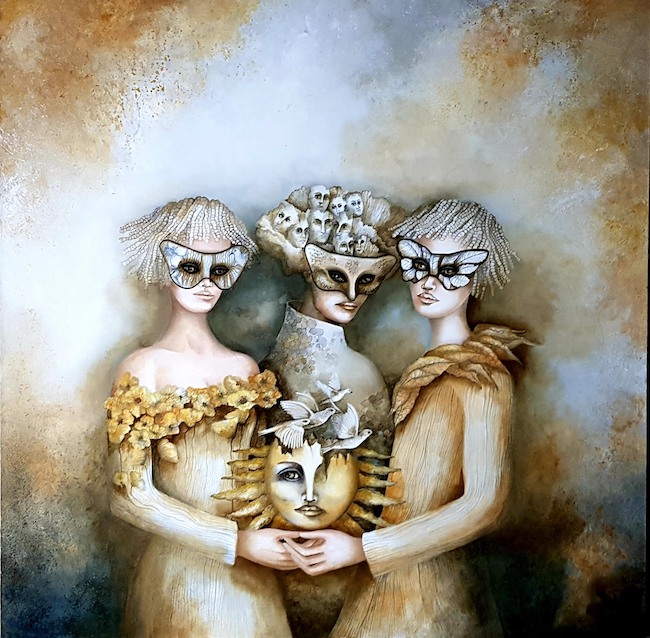
Il messaggio dell’artista è pertanto quello della necessità di un ritorno alla semplicità e alla spontaneità che scaturisce dal contatto con quella natura troppo spesso trascurata nell’era contemporanea, e grazie alla quale è possibile recuperare un approccio più innocente, più orientato ad apprezzare tutto il bello che ruota quotidianamente intorno all’individuo, spesso inconsapevole e distratto da altro.
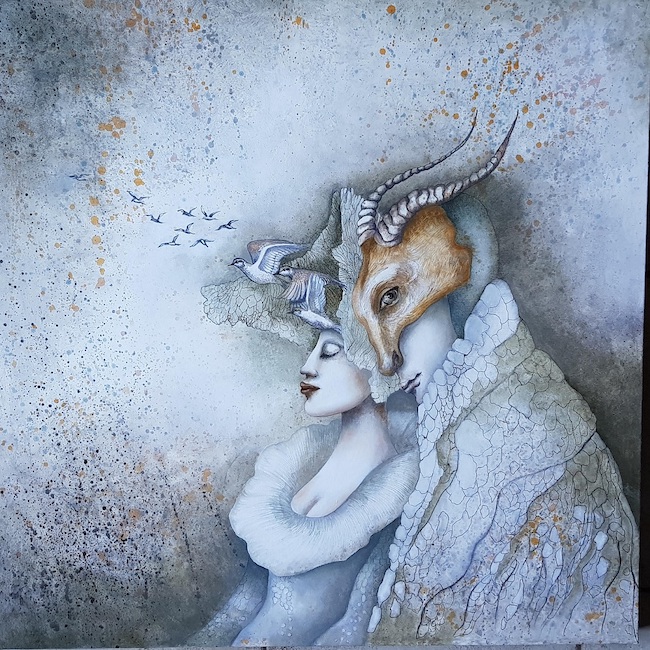
Lo stile pittorico della Cattaneo si incentra sull’equilibrio tra magia e oggettività, tra sfondi sfumati ed evanescenti e figure di personaggi immaginari in cui fiori, piante e animali sono una parte tanto essenziale della loro vita da apparire negli abiti, nei cappelli, nelle vesti di fatto avvolgendoli ed esaltandone l’approccio aperto e sognante; in alcune opere si avvicina a un Pointillisme in cui i piccoli puntini dello stile originario vengono ingranditi come se fossero tondi tasselli di mosaico attraverso il quale l’artista compone i vestiti e i copricapo delle protagoniste.
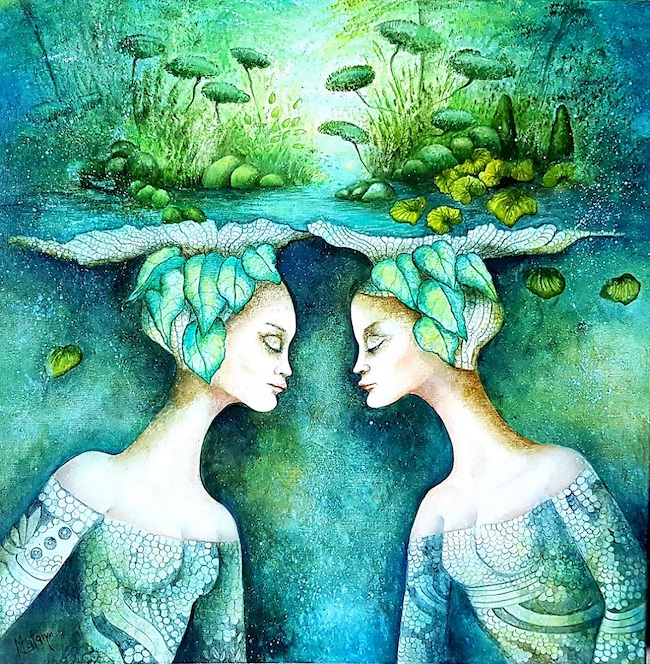
L’opera Principesse Zen presenta in modo marcato il riferimento a quella corrente della fine dell’Ottocento, soprattutto negli abiti delle due donne che sembrano essere l’una il riflesso dell’altra, come se si trovassero davanti a uno specchio in virtù del quale comprendersi e ammettere l’importanza di ciò che appare come un sogno, un ideale, quello che la Cattaneo pone sopra le loro teste, quel cappello eccentrico che diviene di fatto lo scrigno dei sogni, del desiderio di una realtà migliore. Ecco perché l’artista non manca mai di inserire la raffigurazione di fiori e piante, anche laddove si spinge nel mondo delle fiabe inteso come metafora del vivere moderno, perché l’elemento naturale è alla base del suo sentire, enfatizzato pertanto con contorni e colori persino più netti e marcati rispetto all’essere umano.
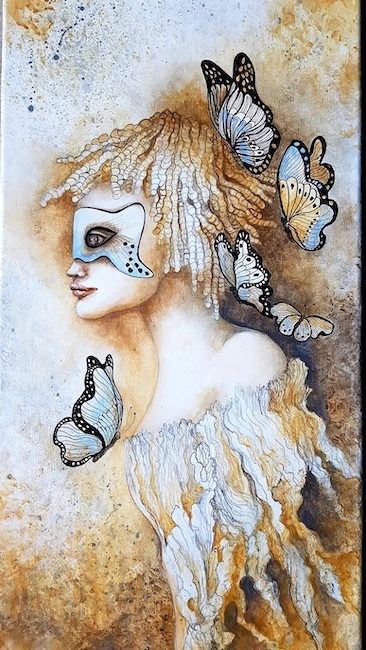
In Il volo delle farfalle lo sfondo è rarefatto tanto quanto la ragazza protagonista, mascherata come se si trovasse a un ballo da favola di fine Ottocento, come se aspettasse che il suo principe arrivi a prenderla per mano; è quello il sogno a cui l’artista sembra invitarla a lasciarsi andare, quel credere nell’incontro che può cambiare il destino, che duri una vita o un solo giorno come le farfalle non importa, ciò che conta è l’intensità di quell’emozione, di quell’aspettativa che sopraggiunga nella vita qualcosa a cui è indispensabile lasciarsi andare. Le tonalità terrose e sfumate contribuiscono a infondere nell’osservatore il senso di sospensione tra realtà e immaginazione, tra capacità di credere che tutto sia possibile e timore che quella leggerezza possa restare solo il sogno di un attimo.
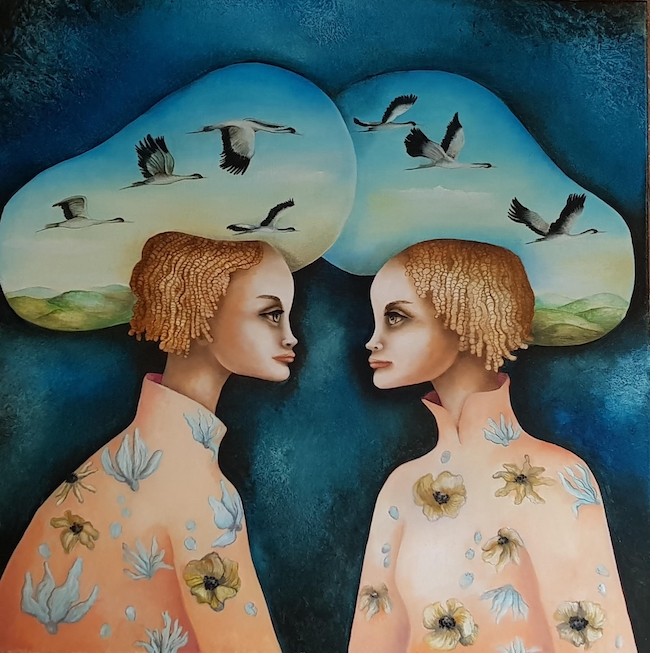
Nella tela Le temps qui passe (Il tempo che passa), le due ragazze, ancora una volta poste l’una di fronte all’altra, sono completamente estraniate dal contesto sottostante, come se avessero bisogno di non considerare ciò che accade nella quotidianità per riuscire a sognare, per porsi nella dimensione onirica ma anche perfettamente in armonia con la loro vera essenza, quella cioè che contraddistingue il loro abito, ornato con fiori, e i loro cappelli, in cui appaiono gli uccelli. In quest’opera Monica Cattaneo sottolinea quanto sia necessario non lasciarsi ingabbiare da una contingenza spesso insoddisfacente perché la vita, l’esistenza, è troppo breve per non godere a piene mani della libertà che ciascuno ha, se riesce a recidere le catene da cui sceglie di farsi imprigionare; optando invece per la consapevolezza e prendendo spunto da quella natura che costantemente è esempio di spontaneità e immediatezza incondizionate, si può raggiungere la felicità a cui ogni essere umano tende. Monica Cattaneo desidera sottolineare l’armonia perfetta che circonda l’esistenza, quel mondo parallelo in grado di ridonare equilibrio se l’individuo è in grado di comprenderne il meraviglioso messaggio di benessere e di autenticità che contraddistingue i fiori e gli animali, ecco perché nelle sue opere tutto è magico lirismo in perfetto accordo con ciò che circonda le sue protagoniste.
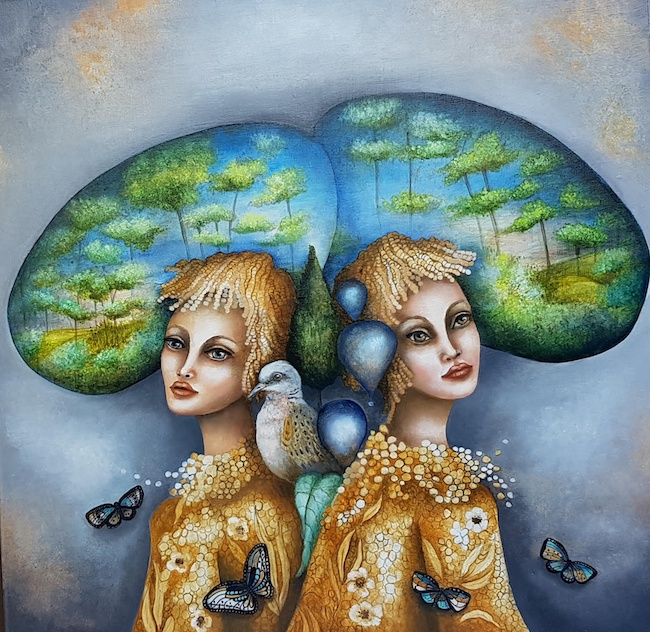
La leggerezza sembra essere uno dei temi più cari all’artista, leggerezza che presenta temi ricorrenti come le farfalle, gli uccelli in volo, il verde tenue con cui arricchisce gli abiti per infondere nell’osservatore quel senso di immersione totale in un mondo spontaneo, ingenuo, semplice, quello che l’essere umano abita, come nella tela Affinità. Monica Cattaneo ha al suo attivo la partecipazione a molte mostre collettive e fiere internazionali in Francia e in Svizzera ricevendo ampi consensi dal pubblico e dagli addetti ai lavori che si sentono trasportati nel suo mondo liricamente magico.
MONICA CATTANEO-CONTATTI
Email: monica_cattaneo@yahoo.com
Sito web: www.monicacattaneo.ch
Facebook: https://www.facebook.com/monica.cattaneo.33
https://www.facebook.com/Monica-Cattaneo-Peintre-720424094647630
Instagram: https://www.instagram.com/monicacattaneoart/
The lyrical magic of Surrealism in the romantic artworks of Monica Cattaneo
Some contemporary artists, rather than tying themselves to objective reality, to explore it or to welcome it as a founding part of their expressive language, choose on the contrary to distance themselves from it, to give life to a world in which everything is more elevated, less contingent, less tied to those ups and downs, those difficulties side by side with pleasant moments that characterise present-day living; the choice to generate a different dimension is often a requirement for a marked sensitivity that needs to abstract itself from everyday life to enter a more poetic universe, musical in its sweetness, almost magical. These are exactly the hallmarks of the artist I am going to tell you about today.
The need to escape from a reality that is too tiring, or sad, or limited, has characterised various artists over the centuries who have placed the accent on a parallel world made of symbols, of hidden meanings, of revelations of the subtle energies that run through and envelop man when he connects with nature, with its impetuosity or simply with a spirituality that is often left in silence; thus before translating into actual pictorial movements, this path was tackled in solitude by a few precursors or singular interpreters of a broader current. Among the first to tackle themes that went beyond rationality, delving into the meanders of fantasy and the impossible was Hieronymus Bosch, who metaphorically, through his unpredictable visionary world, emphasised man’s conflicts with the rules dictated by religion to which it seemed impossible not to rebel; shortly afterwards, however, it was Symbolism that explored the world of the unknowable, of intuitable but untestable sensations that lurked beyond the observed, beyond tangible reality but were revealed by virtue of the artist’s perceptive sensitivity. As the 20th century approached, the world of emotion, of dreams, of evasion from objective reality was consecrated by some great masters considered outsiders of the same movements to which they adhered, such as the dreamer and eternal expressionist child Marc Chagall, the whole of Surrealism where, however, the highlighted dimension was rather that of the nightmare, of the unconscious anxieties and questions about life that manifested themselves in the sleep phase when the rational part was silenced, and finally Magic Realism, which listened to the unconscious enchantment that revolved around the human being who appeared lulled and at the same time estranged by that sensation.
Thus, the artworks of master Chagall, true fairy tales in which the protagonists and reality seemed to belong to the sugar world of Hansel and Gretel, the evanescent and enigmatic atmospheres of René Magritte’s Surrealism, and the simple yet dreamlike charm of the world somewhere between reality and imagination of the great representative of Magic Realism, Antonio Donghi, all of them contributed to directing art viewers towards a level far removed from reality while retaining the characteristics of figuration but readjusting them to the point of view and approach to creative expression of these great masters of the 20th century. The artist of Italian origin but naturalised Swiss citizen Monica Cattaneo seems to achieve in her painting a perfect fusion of the three aforementioned pictorial styles, Marc Chagall’s Expressionism, René Magritte’s Surrealism and Antonio Donghi’s Magical Realism, giving life to a personal and original language in which nature and the human being’s relationship with it become the focal point. Her protagonists, predominantly women, seem to emerge from a parallel world in which the atmosphere is rarefied, suspended between reality and dream, between images traceable to details that the eye recognises and an almost paradisiacal dimension in which all that surrounds the human being is the element of flora and fauna, which becomes the co-protagonist of the canvas itself. The artist’s message is therefore that of the need for a return to the simplicity and spontaneity that springs from contact with that nature that is all too often neglected in the contemporary era, and thanks to which it is possible to recover a more innocent approach, more oriented towards appreciating all the beauty that revolves daily around the individual, who is often unaware of and distracted by something else. Cattaneo’s painting style is centred on the balance between magic and objectivity, between blurred and evanescent backgrounds and figures of imaginary characters in which flowers, plants and animals are such an essential part of their lives that they appear in their clothes, hats, robes, in fact enveloping them and enhancing their open and dreamy approach; in some paintings she comes close to a Pointillisme in which the small dots of the original style are enlarged as if they were round mosaic pieces through which the artist composes the suits and headgear of the protagonists.
The artwork Principesse Zen (Zen Princesses) shows a marked reference to that late 19th century current, especially in the clothes of the two women who seem to be each other’s reflections, as if they were standing in front of a mirror in virtue of which they can understand each other and admit the importance of what appears to be a dream, an ideal, that which Cattaneo places above their heads, that eccentric hat that becomes in fact the treasure chest of dreams, of the desire for a better reality. This is why the artist never fails to include the depiction of flowers and plants, even when she goes into the world of fairy tales as a metaphor for modern living, because the natural element is at the basis of her feeling, emphasised therefore with even sharper and more marked contours and colours than the human being. In Il volo delle farfalle (The Flight of the Butterflies), the background is as rarefied as the girl protagonist, masked as if she were at a fairytale ball at the end of the 19th century, as if waiting for her prince to come and take her by the hand; that is the dream to which the artist seems to be inviting her to let go, that belief in the encounter that can change destiny, whether it lasts a lifetime or just one day like butterflies does not matter, what matters is the intensity of that emotion, that expectation that something will arise in life to which it is essential to let go. The earthy, muted tones help instil in the observer a sense of suspension between reality and imagination, between the ability to believe that anything is possible and the fear that that lightness may remain only the dream of a moment. In the canvas Le temps qui passe (Time passing by), the two girls, once again placed in front of each other, are completely estranged from the underlying context, as if they needed to disregard what is happening in everyday life in order to be able to dream, to place themselves in the dreamlike dimension but also perfectly in harmony with their true essence, that which characterises their dress, adorned with flowers, and their hats, in which birds appear.
In this painting Monica Cattaneo emphasises how necessary it is not to allow oneself to be caged by an often unsatisfactory contingency because life, existence, is too short not to enjoy in full the freedom that each person has, if one succeeds in severing the chains by which one chooses to be imprisoned; instead, by opting for awareness and taking inspiration from that nature that constantly exemplifies unconditional spontaneity and immediacy, one can achieve the happiness that every human being strives for. Monica Cattaneo wishes to emphasise the perfect harmony that surrounds existence, that parallel world capable of restoring equilibrium if the individual is able to understand the wonderful message of well-being and authenticity that characterises flowers and animals, which is why everything in her artworks is magical lyricism in perfect harmony with what surrounds her protagonists. Lightness seems to be one of the artist’s dearest themes, a lightness that presents recurring themes such as butterflies, birds in flight, the soft green with which she enriches her clothes to instil in the observer that sense of total immersion in a spontaneous, naive, simple world, the one that human beings inhabit, as in the canvas Affinità (Affinity). Monica Cattaneo has to her credit the participation in many group exhibitions and international fairs in France and Switzerland, receiving wide acclaim from the public and insiders who feel transported into her lyrically magical world.


